How to Set Up Email in Outlook 2019 for Windows
This article will guide you on how to configure your email account in Microsoft Outlook 2019 for Windows. You’ll learn how to set up your account using SSL hostnames, along with common troubleshooting tips. Once configured, Outlook allows you to manage emails, calendars, and contacts, making it easier to stay organized.
Outlook 2019 Setup Tutorial
- Launch Microsoft Outlook 2019 on your computer.
- If you are opening it for the first time, you'll directly see the window as shown below.
- Enter your Email Address.
- Tick the box that reads Let me set up my account manually.
- Click on Connect.

- If you have already configured email accounts on your Outlook, you can click on File Menu > Add Account.
- If you are opening it for the first time, you'll directly see the window as shown below.
- Select POP or IMAP(recommended) depending on the Incoming Protocol you prefer.

- Based on your preference, select the hostnames, port numbers, and encryption methods for both the Incoming Mail and Outgoing Mail servers from the table below, and then click on Next.
SSL Email Port Settings Outgoing Server SMTP smtp.example.com Port 25/587 Incoming Server IMAP imap.example.com Port 993 Incoming Server POP pop.example.com Port 995 Non-SSL Email Port Settings Outgoing Server SMTP mail.example.com Port 25/587 Incoming Server IMAP mail.example.com Port 143 Incoming Server POP mail.example.com Port 110 
- Click Connect after entering the password for your email account.


- Click on Done to conclude the process.

- You should be able to start sending and receiving messages using your Email Client.

Troubleshooting Common Issues
- Problem 1: Cannot connect to the email server
Solution: Start by checking your internet connection to ensure it is stable. Then, verify that the IMAP/POP and SMTP settings are entered correctly. If the problem continues, confirm that Outlook is not blocked by your firewall or antivirus software.
- Problem 2: Error messages during setup
- Solution: When you receive an error message, note the error code and review your server settings and password. Incorrect login details are one of the most common causes of setup errors. Resetting your password or re-entering the server information usually resolves the issue.
- Problem 3: Emails not sending/receiving
Solution: If your emails are stuck, check your Outbox and confirm that your mailbox has not reached its storage limit. Next, review your outgoing mail (SMTP) settings, as misconfigured servers often prevent emails from being sent. In some cases, removing your account and adding it back to Outlook can fix the issue.
- Problem 4: Outlook continuously asks for my password
Solution: First, confirm your password by logging in to your email through webmail. If the password works there but Outlook still prompts for it, check Windows Credential Manager for outdated credentials and remove them. Creating a new Outlook profile may also help if the problem persists.
- Problem 5: Outlook is slow or freezes
Solution: Performance problems may occur due to an oversized mailbox or unwanted add-ins. Archiving or deleting older messages may decrease the size of the mailbox. Deleting unused add-in components might also help. In the event that Outlook freezes, it still runs without crashing.
For more specific solutions, visit the official Microsoft Outlook support page or check email troubleshooting steps for additional guidance tailored to your specific issue.
Summary
Setting up Outlook 2019 with your email account helps streamline communication by bringing together your email, calendar, and contacts. With the step-by-step setup instructions above and troubleshooting tips, you’ll be able to resolve most issues quickly. For additional help, check Microsoft’s official support or reach out to your hosting provider.
If you need further assistance, feel free to contact us via Chat or Phone:
- Chat Support - While on our website, you should see a CHAT bubble in the bottom right-hand corner of the page. Click anywhere on the bubble to begin a chat session.
- Phone Support -
- US: 888-401-4678
- International: +1 801-765-9400
You may also refer to our Knowledge Base articles to help answer common questions and guide you through various setup, configuration, and troubleshooting steps.